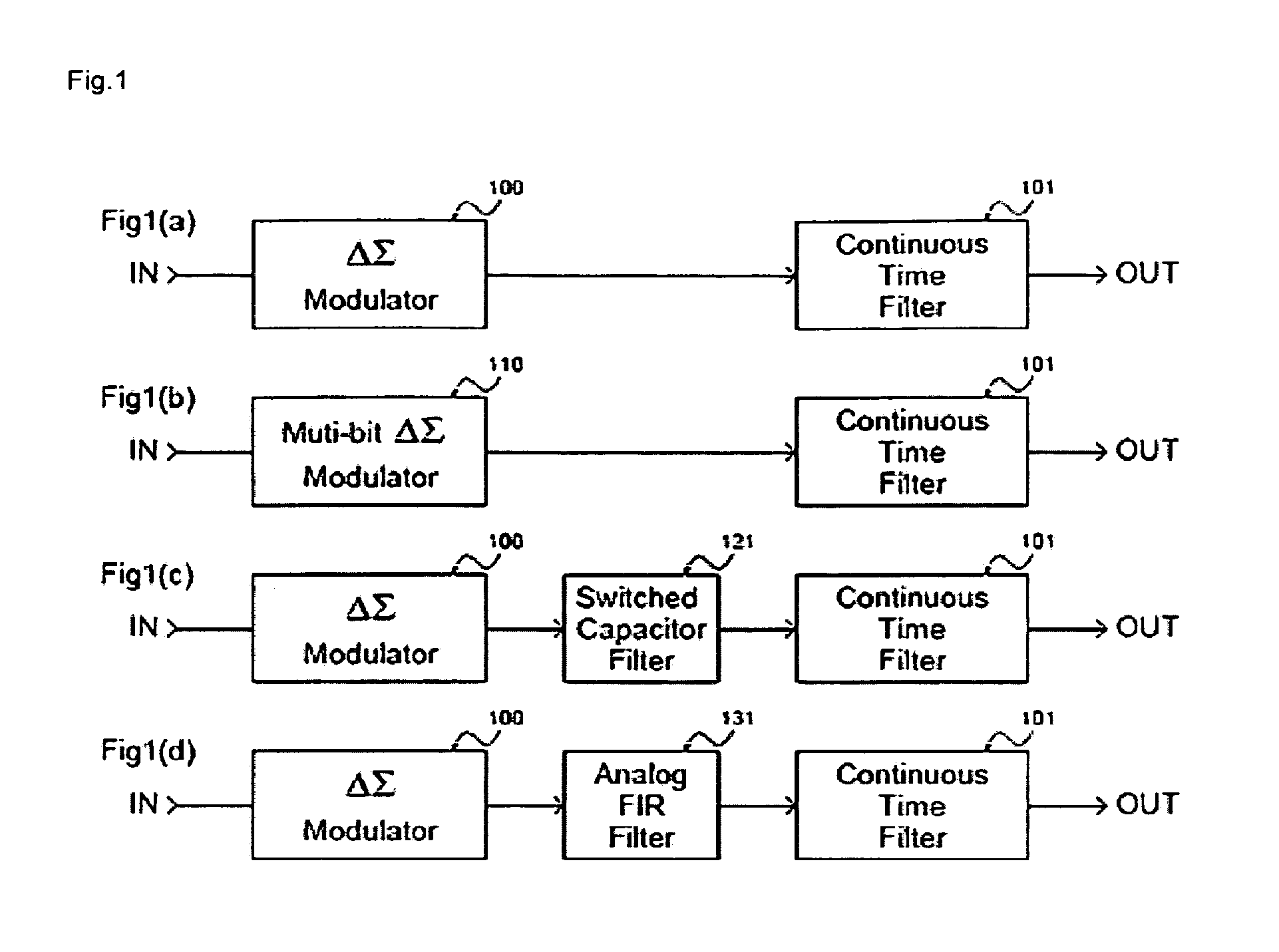Digital/analogue conversion apparatus
a digital/analog conversion and digital/analog technology, applied in the direction of code conversion, frequency response correction, filters, etc., can solve the problems of non-linear noise, difficult to reproduce high-definition audio signals, and inconvenient operation, so as to reduce out-of-band quantization noise and increase in-band noise
- Summary
- Abstract
- Description
- Claims
- Application Information
AI Technical Summary
Benefits of technology
Problems solved by technology
Method used
Image
Examples
example one
[0081]FIG. 6 shows a first example in which an analog FIR filter and a post filter is placed after a cascade type delta sigma modulator of the digital analog conversion apparatus of a preferred embodiment. In the present example, the first stage of the cascade type delta sigma modulator is comprised of a single bit internal modulator and the second stage is comprised of an n bit internal modulator.
[0082]Here, a digital input signal (510) is input to a first stage internal modulator (201) of the cascade type delta sigma modulator, the second stage internal modulator (202) is connected by a cascade connection to the first stage internal modulator (201), and an output signal (520) output from the first stage internal modulator (201) is input to an analog FIR filter (301). A (1−z−n) calculation of an output signal (530) output from the second stage internal modulator (202) is performed by a digital signal process block (601). An output (631) form the digital signal process block (601) i...
example two
[0090]FIG. 9 shows a second example of the digital analog conversion apparatus of a preferred embodiment. In the present example, the first stage of the cascade type delta sigma modulator is comprised of a single bit internal modulator and the second stage is comprised of an n bit internal modulator. As is shown by the expression 9, when the order of the internal modulator is the first order, the transfer function of the second stage is (1−z−n)·1. Because (1−z−n) is digitally processed, it is necessary to analogically calculate 1. Here, the input signal Y2-m (632), which is converted into a thermometer code by the formatter, is firstly input to the selector (910), and a unit group comprises drive buffers (901), which are connected to each of the bits from the outputs of the selector, and resistance elements (902) in which each end is connected to one of the drive buffer and each other end is connected to an output terminal so that a weighted voltage is added as an analog signal. In ...
example three
[0092]FIG. 10 shows a third example of a digital analog conversion apparatus of a preferred embodiment. In the present example, the first stage of the cascade type delta sigma modulator is comprised of a single bit internal modulator and the second stage is comprised of an n bit internal modulator. As is shown by the expression 10, when the order of the internal modulator is the second order, the transfer function of the second stage is (1−z−n)·(1−z−1). Because (1−z−n) is digitally processed, it is necessary to analogically calculate (1−z−1). Here, the input signal Y2-m (632), which is converted into a thermometer code by the formatter, is firstly input to the selector (1010) and secondly input to one of post filter units (603), which corresponds to each bit of the output (1020) of the selector. A post filter unit (603) is comprised of a delay element (711) formed by a DFF which enables one clock delay, a drive buffer (712) which is connected to an input via a switch (715a) which is...
PUM
 Login to View More
Login to View More Abstract
Description
Claims
Application Information
 Login to View More
Login to View More - R&D
- Intellectual Property
- Life Sciences
- Materials
- Tech Scout
- Unparalleled Data Quality
- Higher Quality Content
- 60% Fewer Hallucinations
Browse by: Latest US Patents, China's latest patents, Technical Efficacy Thesaurus, Application Domain, Technology Topic, Popular Technical Reports.
© 2025 PatSnap. All rights reserved.Legal|Privacy policy|Modern Slavery Act Transparency Statement|Sitemap|About US| Contact US: help@patsnap.com



